Industry-Sponsored Student Capstone Projects
2022/2023
In the 2022/23 academic year the industry capstone program was supported by 56 sponsors and 100 real-world projects. Over four hundred students from across the College of Engineering participated. Scroll down to learn more about each project.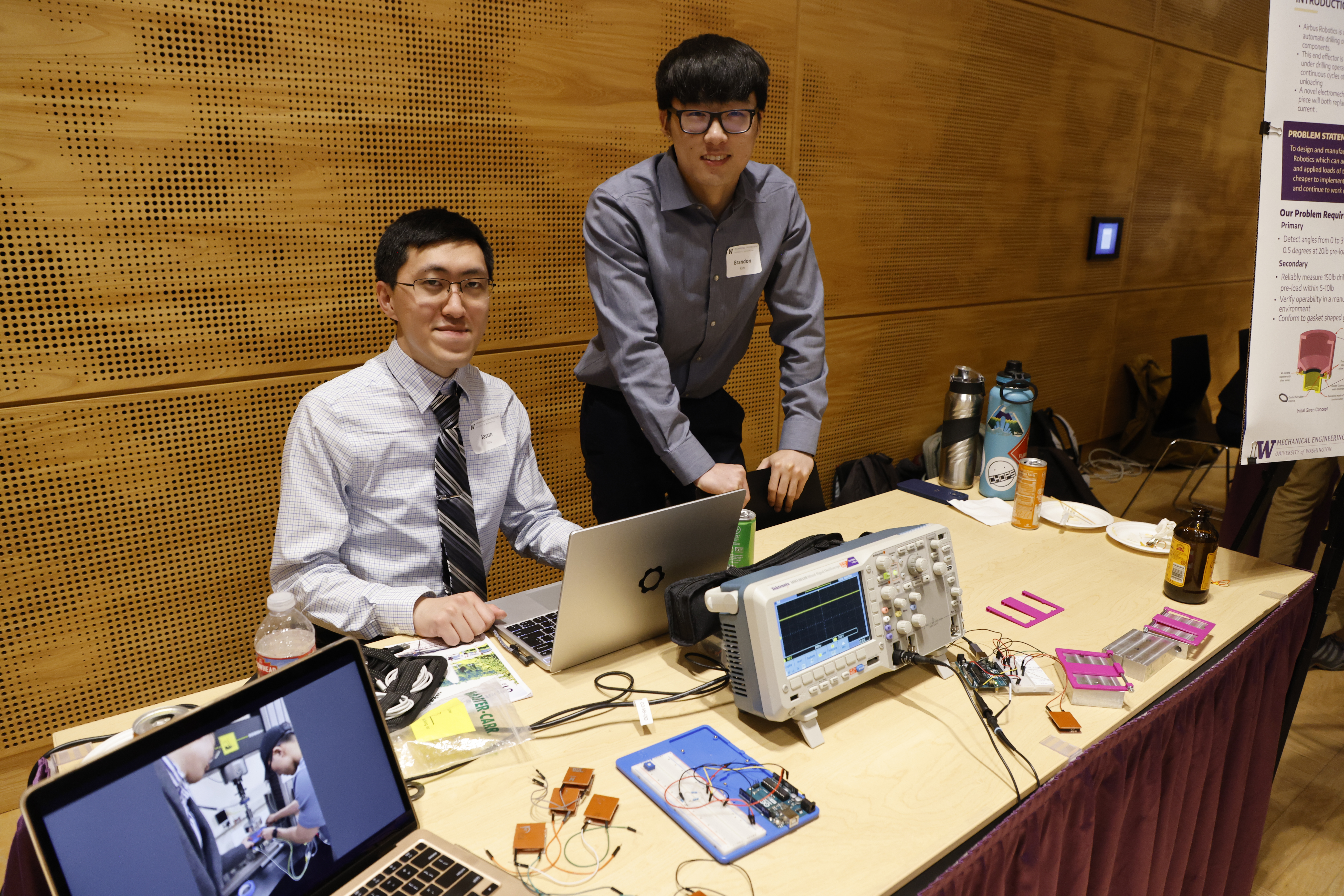
Airbus Robotics
Tactile Nosepiece Assembly
Many of Airbus Robotics' robots use nose pieces on drilling end effectors to normalize to the surface of a panel. This approach may be more robust and less expensive than their existing technology. This student team worked to build a functioning prototype of the device. This student team also worked to collect and assess data on the performance of a nose piece relative to a flat plate (Aluminum plate is okay) and to conduct research on technology necessary to improve the performance of the device -> resolution and range. This student team also sought to simulate the integration of the technology onto a drilling robotic end effector platform (Airbus Robotics provided details for the end effector).
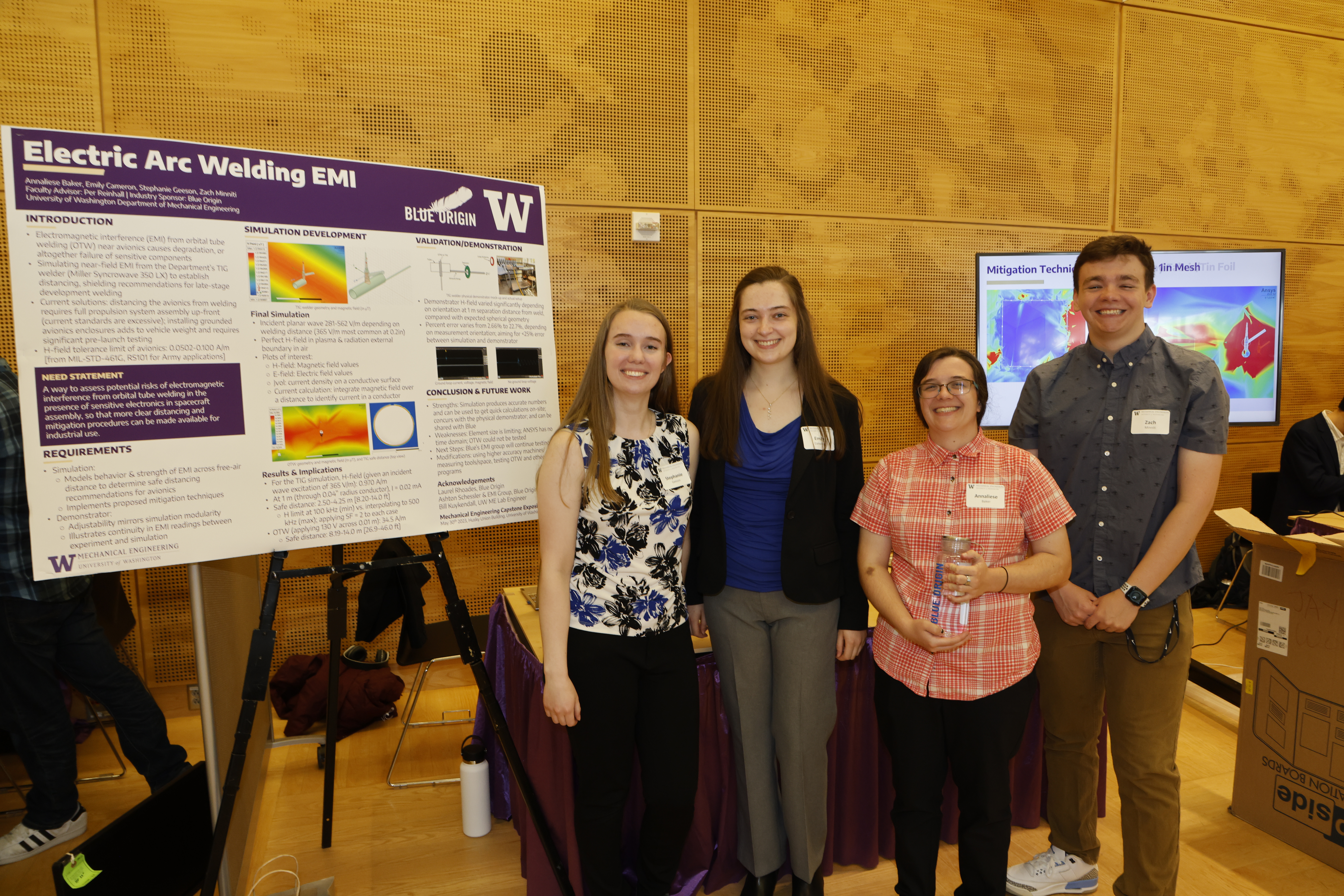
Blue Origin
Orbital Tube Welding EMI Simulation
Orbital Tube Welding (OTW) is a key operation in the assembly of space vehicles. OTW is an automated welding process in which the weld arc is rotated 360 degrees around the tubes that are to be joined, resulting in consistent and reliable welds. Performing welds on an integrated vehicle is avoided because the electromagnetic interference caused by the OTW equipment is a significant risk to avionics components on the vehicle. However, occasional welding near avionics components is necessary to accommodate late component arrivals or to replace a faulty line. This student team worked to simulate the electromagnetic interface caused by orbital tube welding to roughly gauge the risk of welding near avionics components. This student team worked to design, model, and build a demonstrator that includes a weld location, common avionics components, and locations for EMI sensors. This demonstrator is intended be used to analyze and validate a model of EMI at specific locations on a space vehicle as a result of orbital tube welding.
Boeing
AM Machine Gas Flow Characterization & Improvements
Gas flow in the metal AM printers is a key process variable. Recirculation and non-uniformity of the gas flow in the printer can be a source of material defects. Using the a mock-up of the EOSM290 printer built by the 2022 capstone team, this student team worked to design & build gas flow devices to reduce the recirculation and non-uniformity within the printer and test them, using Particle Image Velocimetry (PIV) to characterize the improvements. Students also worked to print and fatigue testing material to demonstrate the impact of gas flow improvements or different gas flow settings. The outcome this student team worked towards is to generate PIV analysis of the baseline gas flow in an EOSM290 printer, design devices to improve the gas flow, and generate PIV analysis of the improvements. Students also worked to analyze materials printed with the improvements and/or different gas flow settings to demonstrate the impact on material properties (fatigue) from gas flow.
Boeing
AM Tooling & Internal Structures
Previous FSAE aerodynamic wings were manufactured using traditional machined foam and polymer features to create a defined shape. With these types of tools the internal structure has to be removed after cure, and once removed are left with a hollow structure. A slit is placed on the rear facing edge to allow access for the internal supporting structure to be installed. The traditional method consists of multiple steps, and this capstone hopes to reduce these steps. This project was meant to assist in the students learning about additively manufactured (AM) tooling and topology optimization structures within a composite aerodynamic wing. The AM sub-structure could be used for multiple purposes; to support in tooling for composite layup, curing of the composite wing, and structure to support on the car. The process aimed to help reduce manufacturing time and create an opportunity for students to understand the interaction between composites and polymers.
Boeing
Carbon Fiber Tube Space Frame
The project team attempted to design joints for a carbon fiber tube space frames. For a steel tube space frame a triangulated joint is welded together, however with carbon fiber, welding is not possible. We proposed making metal joints where the carbon fiber tubes can slide into the joint and be bolted together. Using the bolts, we could still attempt to use perimeter shear data and tearout calculations.
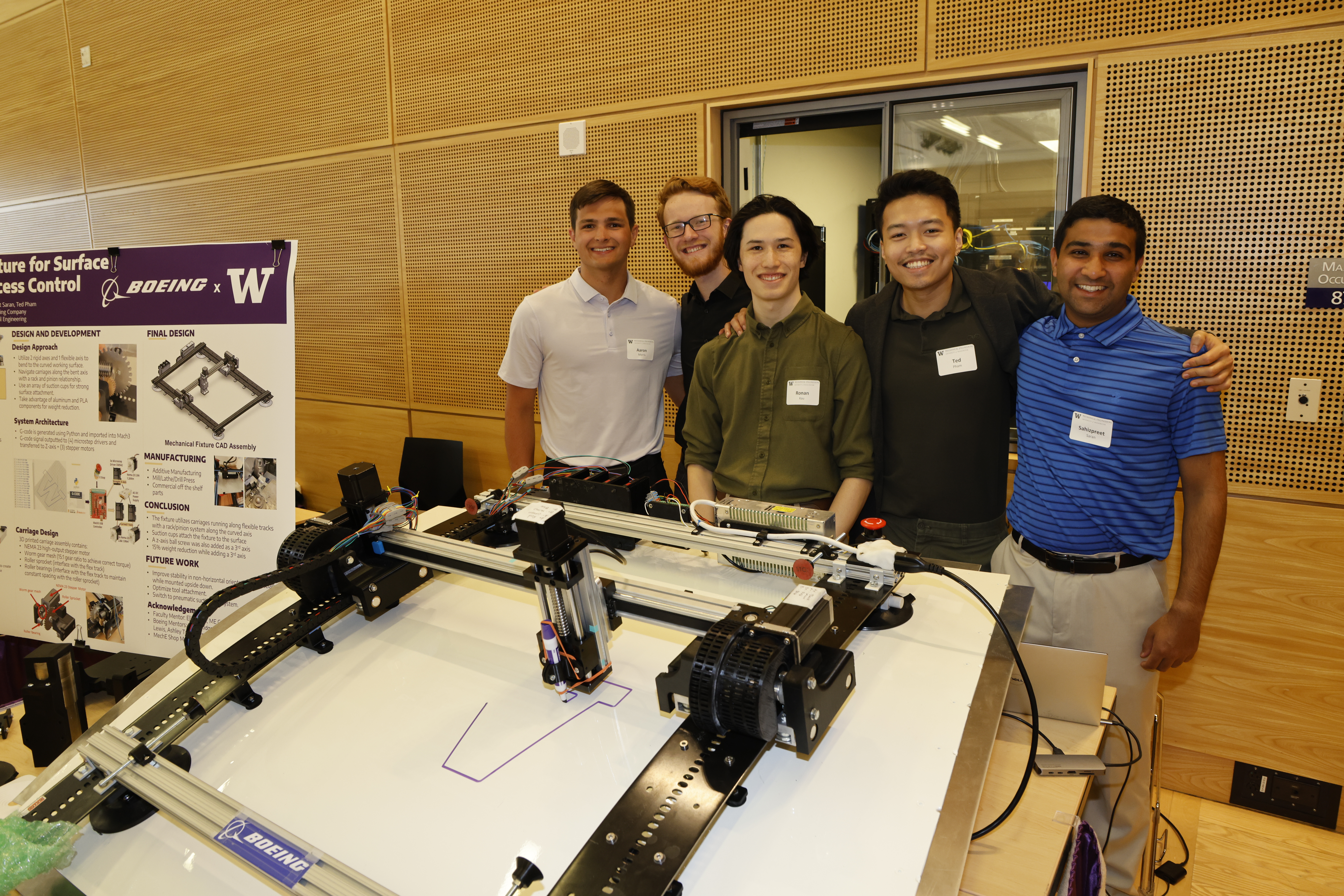
Boeing
Mechanical Fixture for Surface Treatment Process Control
This project provided students an opportunity to learn more about mechanical design, system fabrication, automation, surface preparation of thermoplastics, and structural repair of composites. The hope was that students would have an opportunity to gain some hands-on experience on system design, build, and implementation. This student team worked to advance and improve on a mechanical fixture /guidance system for use with the different commercially available portable options for surface treatment of thermoplastics (plasma/laser/UV light) to achieve the following: 1. Accurately control prescribed pass speeds for all options 2. Guided consistent overlap between passes 3. Maintain constant, controllable nozzle distance from substrate 4. Variable clamping mechanism for different nozzle sizes 5. Minimum 3-axis numeric control 6. Clamping system with vacuum suction cups to ensure secure completion of surface treatment coverage Anticipated deliverables for this project included: 1. Report, including any design(s), prototype(s), and/or simulation(s) developed during the effort. 2. Mechanical proof of concept demonstration, if feasible.
Boeing
Optimized Gooseneck Hinge
This student team aimed to design, analyze, fabricate (using selected aerospace grade material) and test a goose neck hinge component in tension and compression using the UW ME load test frame. Any successfully tested hinge component is to be provided to Boeing at the conclusion of testing for further evaluation. The hinge has unique envelope requirements to fit in available space. A large portion of the exercise was to select a material and fabrication technology that would both meet the prescribed requirements, and be tested within the allotted time frame and project budget. Aluminum, steel, titanium, CFRP may be selected. This hinge design is similar to the DC-9 passenger entry door hinge.
Boeing
PBF Build Process Interruption Study - Phase 2 Fatigue Study
The existing UW Round Robin focuses on EOS M290 intra-build, intra-machine, and inter-machine variation study in both static and fatigue material behavior. The study is supported by industrial members and FAA. With the project progress in 2020 and 2021, there are ideas about where these variations may come from. With the existing UW Round Robin study transition into fatigue focus and literature studies, performance variation exists and many studies are in place to further understand the variation sources. Besides typical process parameter studies, the effects on the process/ machine induced build variation is yet to be well understood. By using Round Robin data, it greatly reduces the amount of preparation and design of experiment time, allowing students to focus on one of the key interests in variation factor. The data received from the interruptions study will continue to support production non-conformance decision. This student team worked to leverage the existing DoE design in Round Robin study and design interruptions in the build process and study its material behavior tolerance on various interruptions. Anticipated deliverables included: • For the interruption design, this student team will work to design interruption locations and degreed of the interruptions • This student team will work to identify effects on fatigue performance for machined coupons with and without HIP • This student team will work to create documentation on the surface variations in as printed condition • This student team will work to understand defect characterization via NDE such as SEM and Micro-CT
Boeing
Structural Effects of Moisture Ingression of Aramid Core
Honeycomb core panels (sandwich structure – typically airplane control surfaces and fairings) have been known to collect moisture during the operation of an airplane. The entry points for moisture ingression are commonly from impact damage, missing/damaged sealant or missing/damaged finishes. During Ground Air Ground (GAG) cycles, moisture can accumulate in the honeycomb core cells. During repair/maintenance activities, the moisture is removed and dried out. Often, it is assumed that there is degradation in the strength characteristics of the honeycomb core and the core is removed and replaced. To better predict the strength degradation, this student team worked to have a physical test and/or an analysis method that would provide the data necessary to alleviate the need to remove and replace the honeycomb core and substantiate that the core maintains adequate strength. This student team sought to learn how to develop a test procedure to characterize the effects of moisture ingression in honeycomb core panels and whether those effects are reversible when exposed to typical repair drying procedures. Outcomes the students worked towards included: 1. Documenting results of mechanical testing of soaked vs. control coupons. 2. Publishing conclusions and recommendations of testing
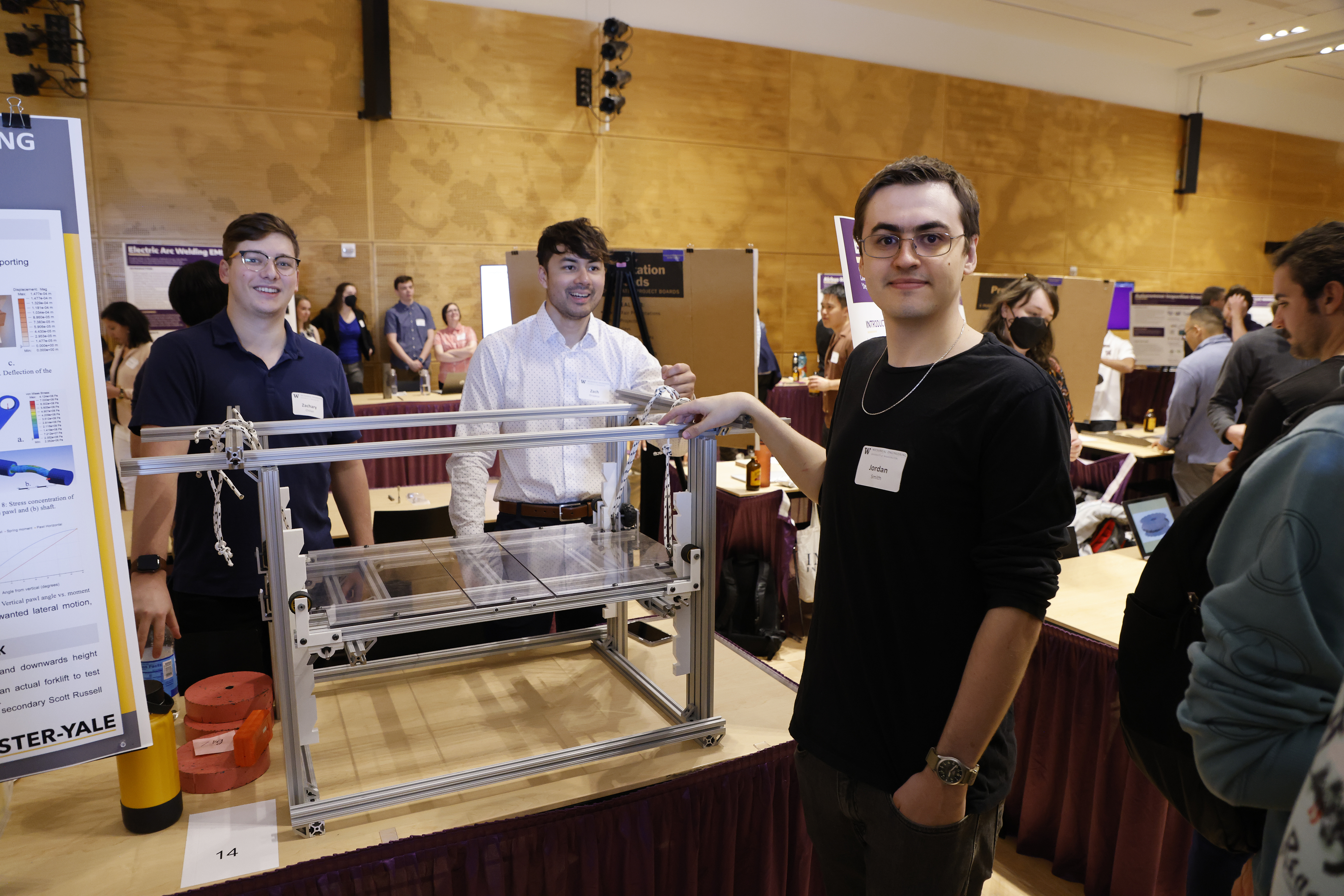
Hyster-Yale Group (HYG)
Adjustable Height Test Load Tower
This student team worked to design an adjustable height load tower capable of holding 5500kg test loads at up to 5 meters high to be used in the testing/validation of lift trucks. Motivation: During the development of Hyster-Yale Group's lift trucks, there is often the need to exercise a truck on a test course that involves moving a load onto and off of a platform at a specific height. The test height is often based on some percentage of the maximum lift height of the truck or some other height that represents a specific customer use case. Currently Hyster-Yale Group's test load towers are all fixed heights, and because they offer such a large range of lift height options it means there isn't always a perfect height tower for the test they want to run. By moving to an adjustable height tower design, they aim to improve the effectiveness of their testing that requires specific lift heights. Desired outcomes for this project included: -Robust and reliable load tower design that can be used for many years of testing to come -Design optimized for manufacturability and efficient use of materials -Engaging and educational experience for the student team Desired deliverables for this project included: -3D model of design -Scale model / prototype -Full manufacturing drawings and BOM -FEA analysis report verifying strength of structure and adjustment / latch mechanism(s)
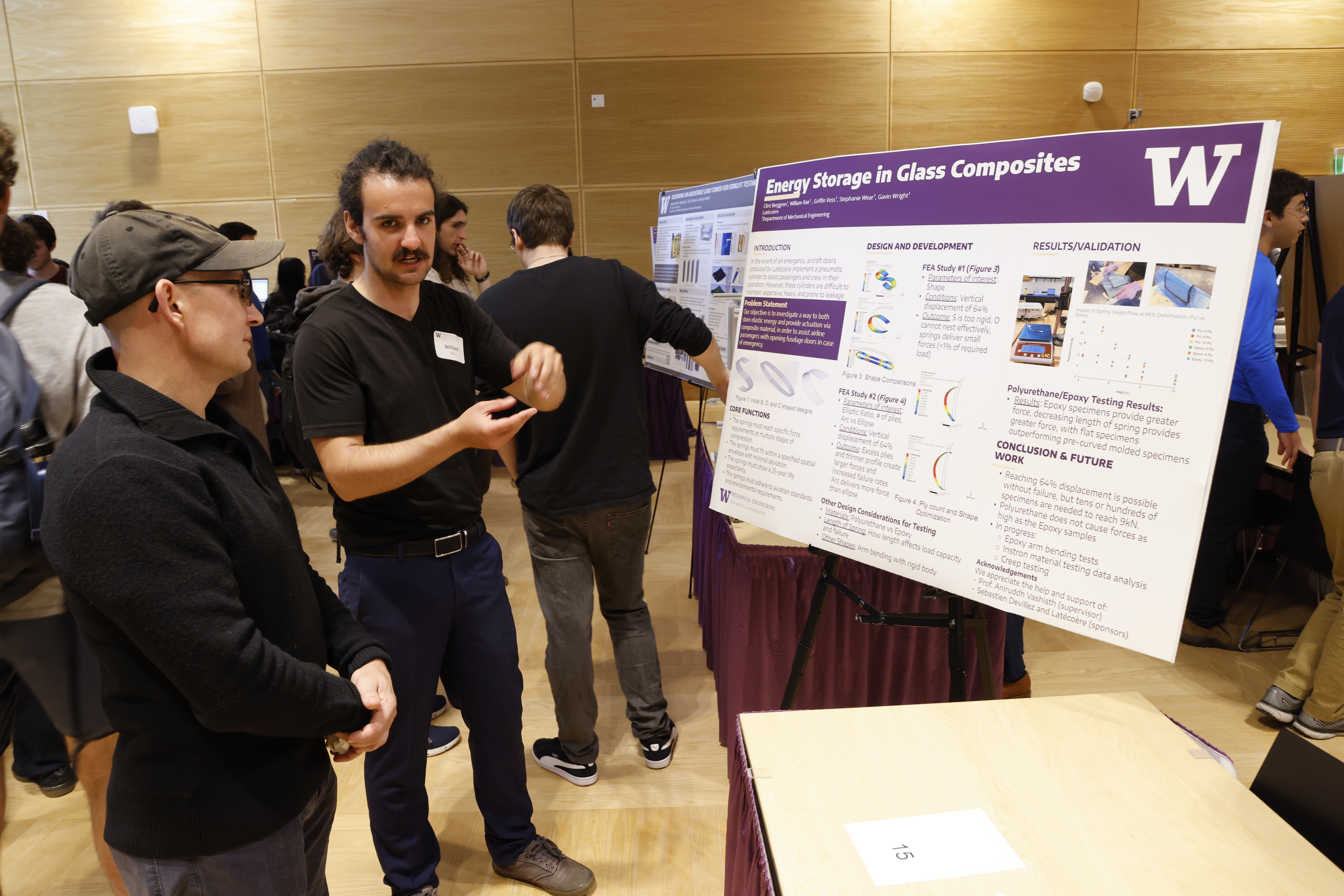
Latécoère
Accumulation of Elastic Energy Using Glass Composite
Emergency systems require to be autonomous in energy. One way to store energy is to maintain elastically deformed adequate structure. This student team worked to address this problem by working to develop a specific structure composed of C spring made from glass fiber / epoxy composite. This student team also worked to develop a light and reliable way of storing mechanical energy while remaining possible to produce at low cost and at high rate. Anticipated deliverables for this project included: - A design proposal - A stress validation. - Coupon test evidence. - RC estimation - Weight evaluation - Investment's evaluation - Risk assessment at the end of the project
MilliporeSigma
Assurance GDS Kit Packaging Redesign for Sustainability
MilliporeSigma is making sustainability a priority and is looking for any avenues to improve our company's/products' environmental impact. One of MilliporeSigma's flagship products for the Food Safety industry is the Assurance GDS test kits for pathogen detection. Recent education into sustainable practices has brought awareness to the waste incorporated in traditional shipping packaging. Reducing packaging/shipping waste can have significant, compounding reduction in waste. The GDS test kit packaging has been selected for improvement. MilliporeSigma would like the help of UW students to work to improve the sustainability to the Assurance GDS packaging by reducing waste. This student team worked to develop and demonstrate proof-of-principle of a viable solution for GDS test kit package redesign, show package testing (drop testing, etc) , and provide predictive models for sustainability improvements, cost differences, reduced carbon footprint, etc.
National Security Innovation Network
Optimize PME Cooling
The National Security Innovation Network (NSIN) is a network in the U.S. Department of Defense (DOD), aimed at connecting DOD entities with academic and venture partners to innovate new solutions for DOD-member challenges. Primary Mission Equipment (PME) is largely comprised of air-cooled, Commercial-Off-The-Shelf (COTS) components, which are typically not ruggedized to military specifications (MILSPEC) and therefore have lower temperature limits and typically require more cooling than MILSPEC PME. However, due to frequent tech-refresh-driven PME upgrades and the complexity of various facilities’ cooling systems, it is common practice to overcool the PME. This is generally a result of [1] poorly defined temperature requirements for the PME (e.g., weakest components drive the cooling requirement for the entire PME container/rack even though a slight overtemp will only result in a reduction of warrantied service life, which often greatly exceeds the actual tech-refresh schedule, and not a loss in system performance); [2] non-optimal PME rack designs (e.g., the most rugged components, typically power supplies, are not cooled last, rather than saving the colder in-line cooling air for the weaker components); and [3] poorly controlled or non- optimized facility cooling systems. For the purpose of the NSIN problem statement, this student team will work to focus on [1] and/or [2]. For [1], this student team worked to review typical mission COTS PME and using a combination of literature, analysis, and test, quantify a relationship between temperature requirements, (reduced) service life, and performance; the student team also worked to include a recommendation for reducing cooling costs while maintaining performance, based on the service-life findings in relation to typical PME refresh cycles. For [2], the student team then attempted to analytically show the energy savings relationship between an “optimal” PME rack design (i.e., in-line cooling position based on temperature specifications) and a non-optimal design. For completeness, the student team aimed to show the relationship in [2], including the findings from [1]. [1] Northeastern University Program Director, National Security Innovation Network (NSIN), U.S. Department of Defense, 508.925.0337, jgriffin@nsin.us, http://www.nsin.mil/
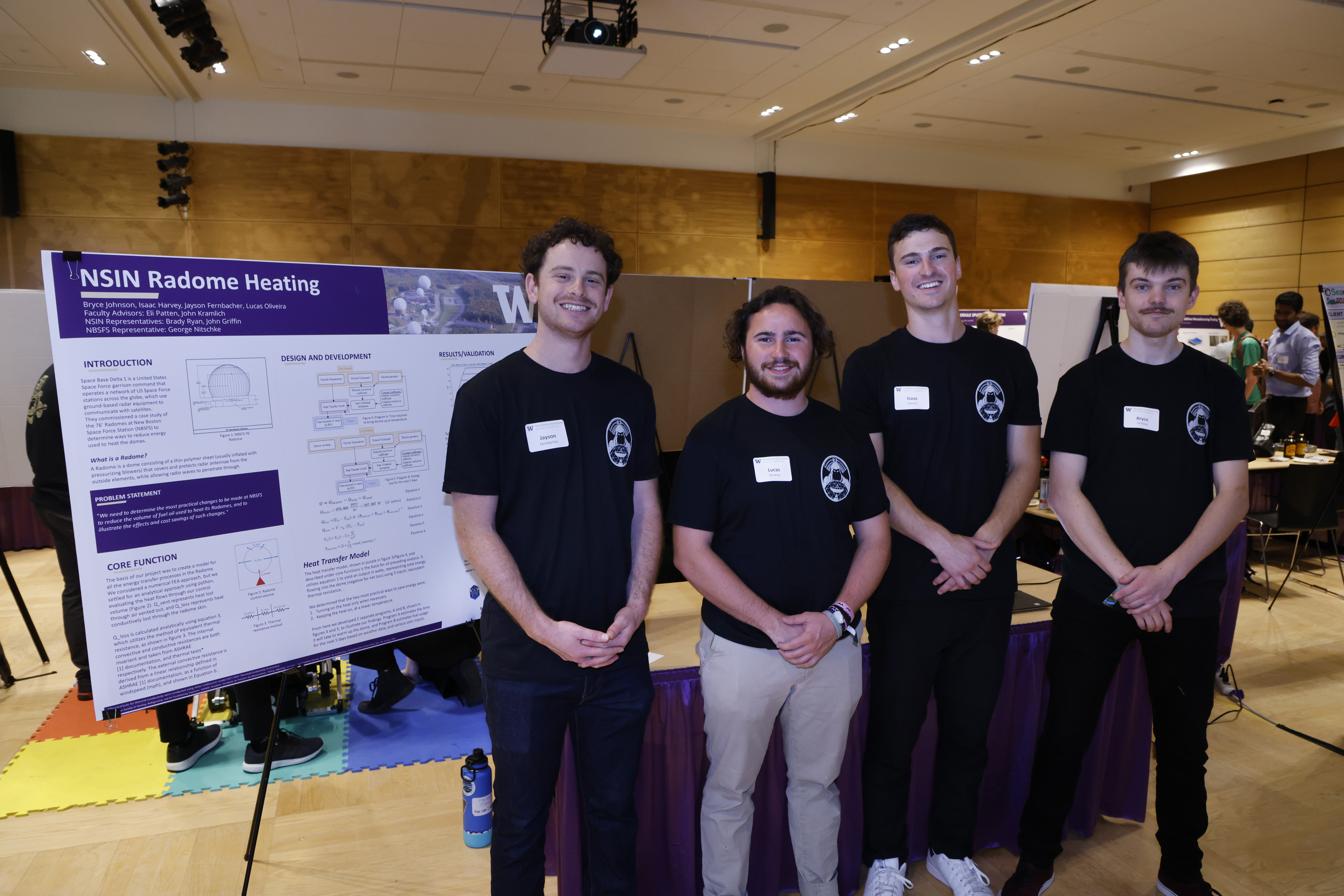
National Security Innovation Network
Optimize Radome Heating
NSIN is a network in the U.S. Department of Defense (DOD), aimed at connecting DOD entities with academic and venture partners to innovate new solutions for DOD-member challenges. New Boston Space Force Station's (NBSFS) radomes are heated with fuel oil in the winter, expensive and an ever-increasing risk to resiliency, particularly considering current events in eastern Europe. Two of NBSFS' radomes are also de-humidified to, presumably, prevent interior condensation. There is no specific Primary Mission Equipment (PME) temperature requirement driving the radome interior temperature, as all the PME is located in an equipment room inside the radomes, which is controlled separately from the radome interiors. This student team worked to reduce the wintertime temperature set point in the NBSFS radomes from 45°F to 35°F, which would save ~10% of the annual fuel oil requirement. This student team also sought to prevent interior condensation freezing as well as help diminish external snow build up. Ideally, this student team worked to create or identify one point on the interior of the radome which could be used to regulate the requisite temperature, and thereby save fuel oil and reduce the NBSFS carbon footprint; the “smart point” could be measured/monitored, e.g., with infrared, and the regulation logic would be modeled as a function of outside air temperature, interior humidity, weather, sunshine, snow accumulation, etc. Tasks the student team worked to accomplish included: [1] review the literature, conduct analyses and modeling, to establish a notional “smart point”, if possible [2]develop the logic for controlling the radome interior temperature to achieve the objective of minimizing fuel oil for heating while maintaining the required radome mission performance.
PACCAR
Automation of Dash Tester Connections
This student team worked to create an automated solution capable of accurately and repeatedly connecting and disconnecting a plate containing multiple cable connectors to the connectors on the rear of an assembled dash to be tested at the production plants. This automation could potentially be used in a plant, along with all of the information (plans, source code, diagrams, et cetera) required for the Manufacturing Support Team to build more and was intended to free up test operators to be able to use their time more efficiently and reduce the amount of time required to test each dash. The intention was to save time and money for the plant and the company as a whole. This was the final part of a larger effort to automate the testing process and will be extremely valuable to the Manufacturing Support Team and the manufacturing plants themselves.